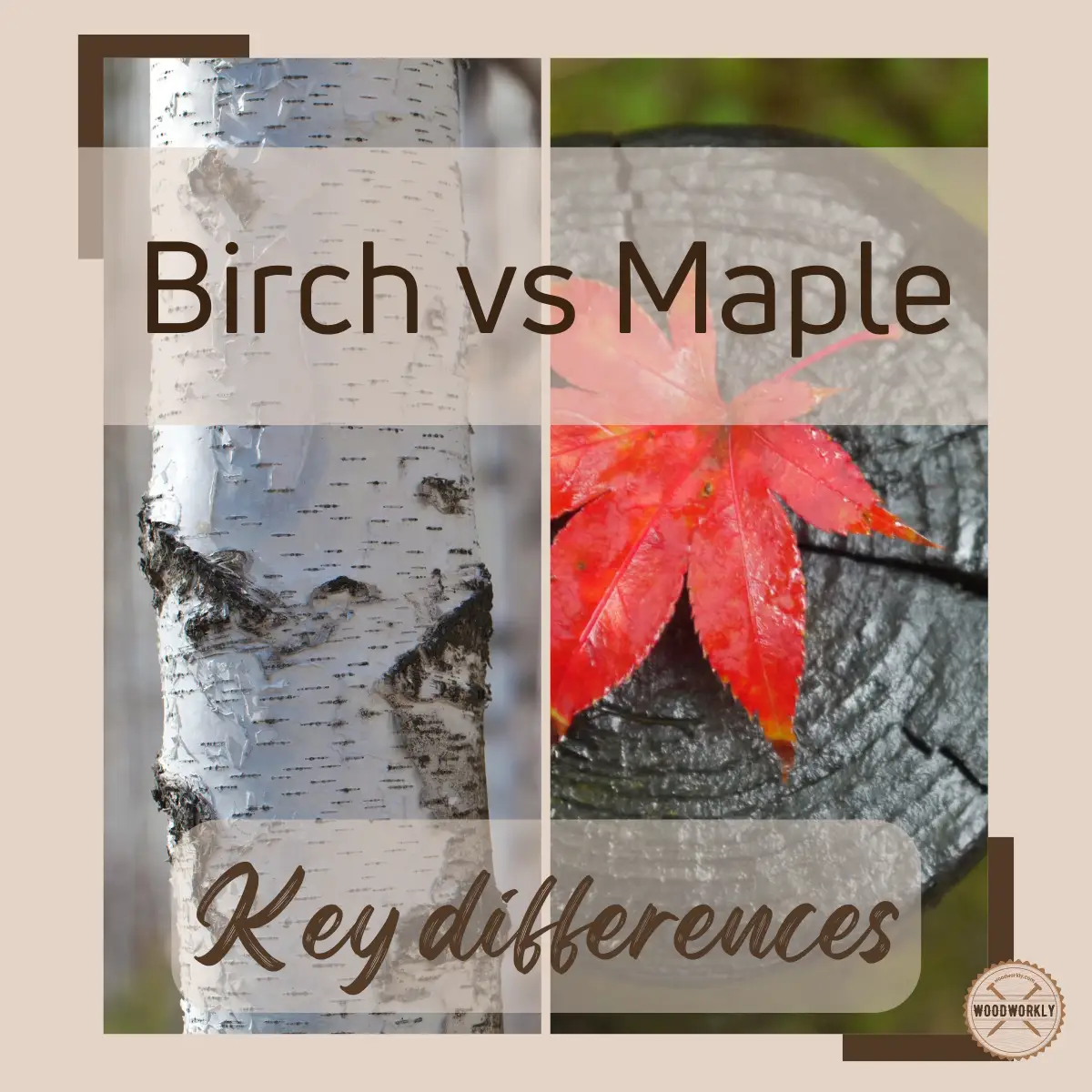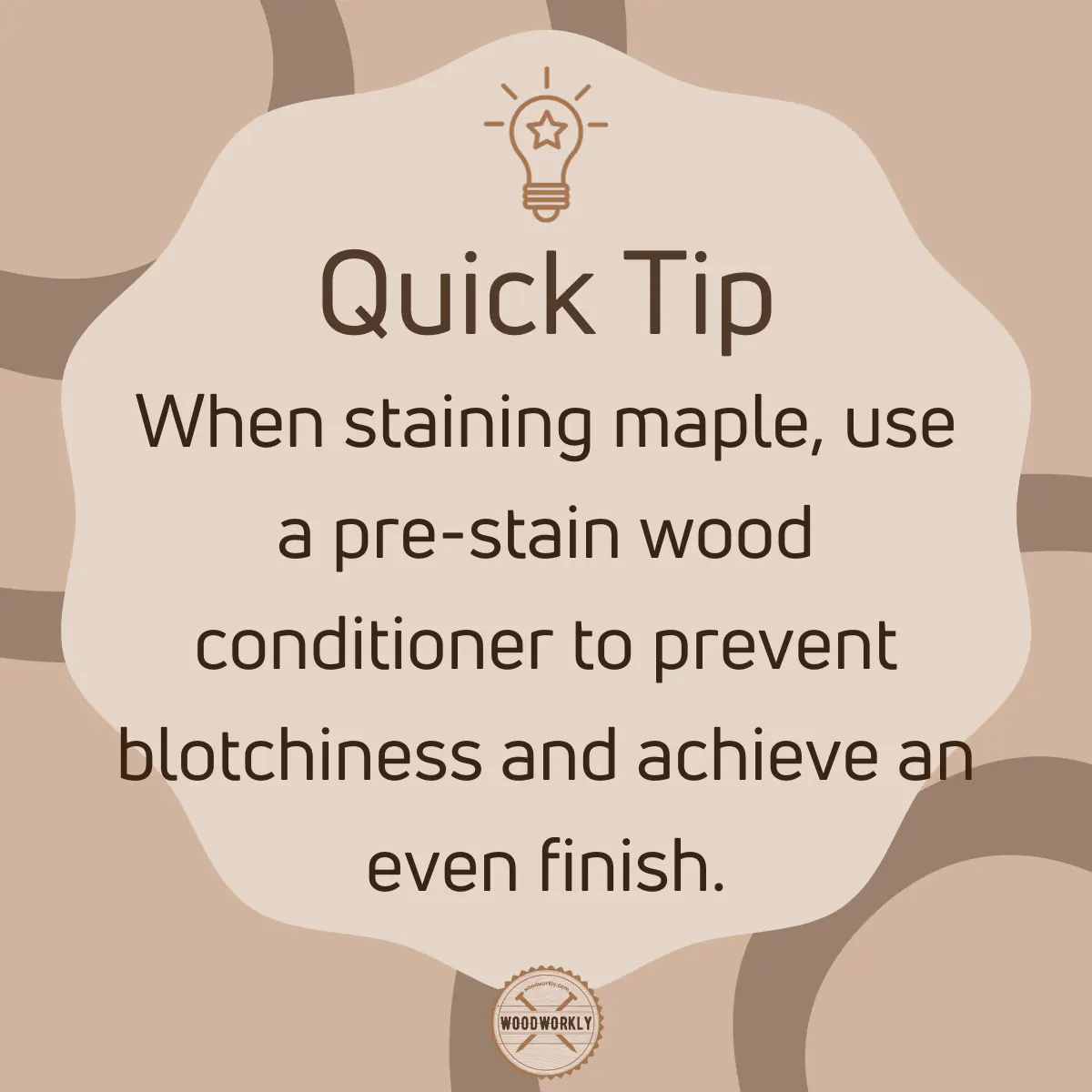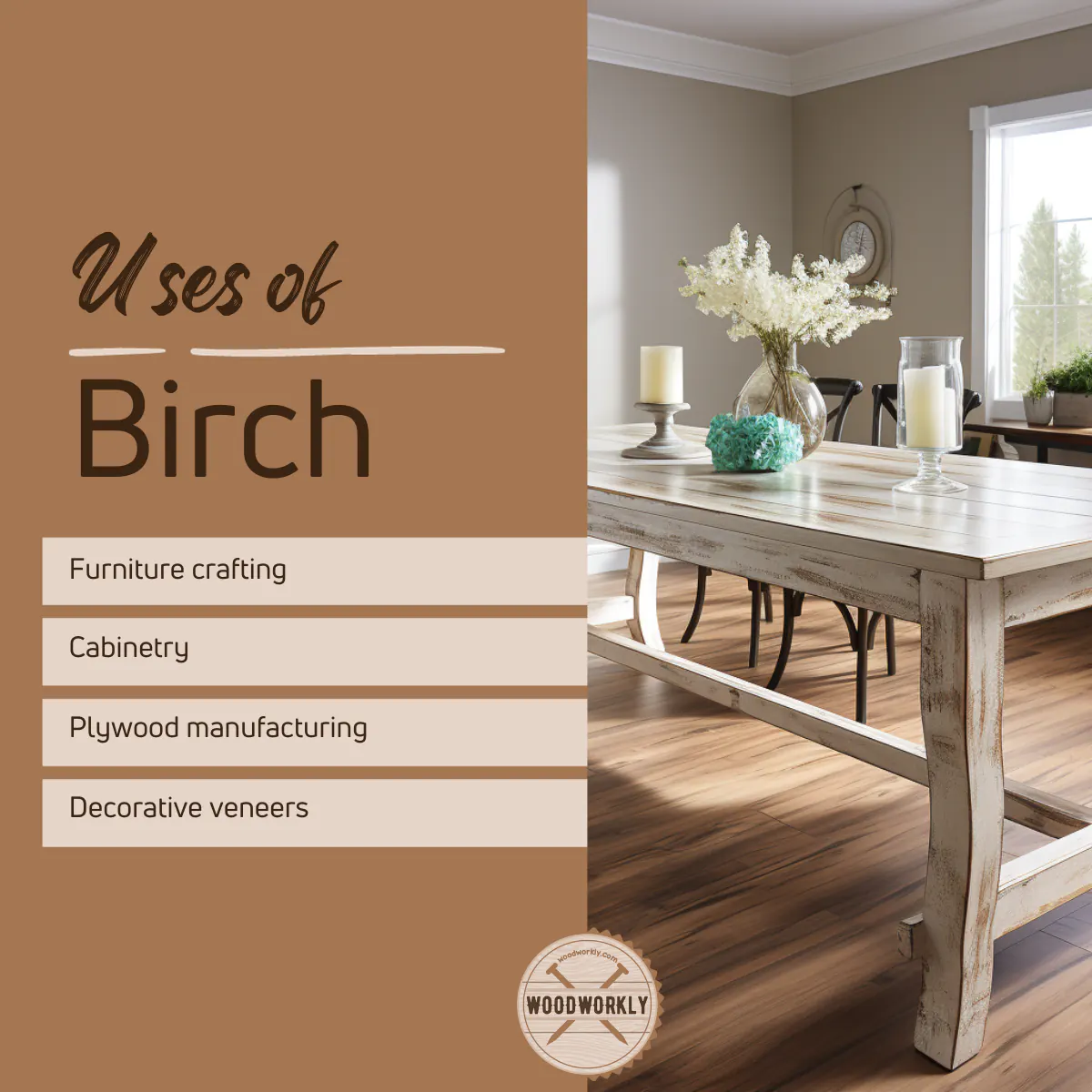Ever marveled at the beauty of wooden furnishings and wondered, Birch or Maple: which reigns supreme? Dive in to discover!

Both birch and maple woods have a light, pale color, often with a slight reddish or yellowish tint. This makes them desirable for furniture, cabinetry, and flooring where a bright, clean look is sought.
But in the early days, I was curious about the differences between birch and maple wood for a heavy-duty woodworking project.
So, I did a deep research about them with the help of woodworking experts and was able to gather lots of details under Birch vs Maple.
Here are the differences between Birch and Maple,
- Birch is more susceptible to wear and infestation.
- Maple is generally more resistant to wear.
- Birch is prone to cracking in dry environments.
- Maple is generally more stable.
- Birch has a Janka hardness of 1,260.
- Maple has a Janka hardness of 1,400-1,500.
- Birch is slightly darker in color.
- Maple is light creamy in color when freshly cut.
- Birch has a looser grain structure.
- Maple has a tighter grain structure.
But there’s a lot more to know about each!

In this article, I’ll explore everything you need to know about birch vs maple so you can choose which one is perfect for your project.
Furthermore, I’ll answer some frequently asked questions as well.
Let’s dig in!

What is Birch Wood?
Birchwood is obtained from well-grown birch trees which are hardwood. Birch trees are native to South America and are deciduous plants native to Europe, Asia, and Japan.
There are about 40 species of birchwood, including common birch, weeping birch, red birch, yellow birch, and white/silver birch.

Characteristics of Birch Wood
Appearance
Birchwood has a yellowish-white appearance. Some varieties are reddish-white or light brown in color. Very similar to maple wood.
At first glance, it can be mistaken for maple wood. The color fades over time.
Hardness
Yellow birch wood ranks 1260 on the Janka hardness scale. It exhibits a fine to medium pore structure, a fine wavy grain pattern, and a satin finish. Birch is a very strong wood like maple.
Strength and Workability
Birch wood is very strong and has elasticity and hardness. It is ideal for profiling, carving, peeling, and cutting.
These properties make plywood a popular choice for manufacturing.
Durability and Construction Use
Birchwood has cross-banded layers of veneers, increasing its durability and resistance to decay. It is widely used in the construction of cabinets, furniture, drawers, shelves and other woodworking and construction projects.
The hollow-free structure of this wood enables easy installation even with screws.
Finishing Qualities
Birchwood is easy to work with, so it is possible to get a good finish with an attractive appearance for birch wood.

Advantages and Disadvantages of Birch Wood
| Advantages | Disadvantages |
| Versatile wood with 40+ species | Not rot-resistant |
| Strong and durable | Expensive |
| Lightweight | Not resistant to wear |
| Aesthetic wood grain | Prone to cracking when too dry |
| Accepts any finish or stain | Not wear-resistant |
| High dimension stability | Birchwood not rot-resistant |
| High resistance to scratches/dents | Cracks when too dry |
| Beautiful hardwood | |
| Extremely versatile |

Uses of Birch Wood
Birch plywood wood has many benefits due to its optimal use. Some of the benefits are given below.
- House Items
- Boxes
- Baskets
- Ground
- Cabinet
- Cutting boards

What is Maple Wood
Maple wood, obtained from maple trees which are hardwood trees, is a strong and attractive material. Maple wood is native to Asia but can be found in many parts of the world, including Europe, North America, and North Africa.
There are more than 130 species of maple trees, including soft maples and hard maples (also known as sugar maples or rock maples).
Maple plywood is a strong construction material made by compressing sheets of wood and covering them with a thin layer of veneer.

Characteristics of Maple Wood
Strength
Maple wood is an exceptionally strong wood with a hardness rating of 1,400-1,500 on the Janka scale, making it a durable wood.
Appearance
Maple wood comes in an attractive range of colors from light cream to light reddish-brown, adding to its aesthetic appeal.
Maple wood features a smooth and stainable grain pattern, making it a favored choice for woodworking and furniture making.
Versatility
Maple plywood is available in a variety of sizes, with the most common being 4×8 feet and ⅛-inch to ¾-inch thick.
This versatility makes it suitable for a wide range of applications.
Popularity
Hard maple (Acer saccharum), also known as sugar maple or stone maple, is a common variety in the United States and Canada.
It is famous for its production of maple sap, which is a key ingredient in making maple syrup.

Advantages and Disadvantages of Maple Wood
| Advantages | Disadvantages |
| Strong and durable | Not very weather-resistant |
| More affordable than comparable woods | Prone to cracks when dry |
| Compatible with all wood stains | Unexciting grain pattern |
| Readily available | Not resistant to weather |
| Versatile (usable in many applications) | |
| Prone to scratches and dents | |
| Low-maintenance wood | |
| Over 100 species are available, adding versatility to applications |

Uses of Maple Wood
Maple wood and maple plywood are used for many things.
- In houses and to make bowling alleys
- High-end furniture-making
- Clock setting
- Fine woodwork
- For decorative walls
- To make cabinets
- Carving projects

Birch vs Maple Differences
Here’re the main differences between birch and maple wood which are important when making furniture and woodwork.
1. Appearance
Maple and birch are woods with different characteristics. Birch has looser, longer horizontal grains than maple and is golden brown in color. Dark maple is darker than light cream in color.
Unlike dark maple, dark birch retains its shade under sunlight and turns yellow or reddish-brown.
Maple exhibits a fine, occasionally even texture with unique grain patterns.
Freshly cut maple is light but darkens over time, making it unsuitable for outdoor use.
Birch is also not suitable for outdoors due to its poor weather resistance.
Birch is slightly darker and has a looser grain structure compared to maple. Both kinds of wood are favored for their aesthetic appeal.
2. Durability
Maple and birch plywood are popular choices for a variety of woodworking projects.
However, their durability depends on specific usage and environmental factors. With a high Janka hardness of 1450, Maple wood is exceptionally hard and resilient.
It is ideal for resisting moisture, heat, and UV rays. It is ideal for kitchen cabinets and furniture. It is less likely to crack. With proper maintenance, it can achieve long-term good survival.
Although birch wood is not as strong as maple, it is suitable for long-term projects and offers good durability. However, it is less resistant to insect attacks and decay.
It should not be used for outdoor applications without proper finishing. Birch maintains its color even when exposed to sunlight.

3. Sustainability
Both woods have advantages when it comes to sustainability.
Maple trees grow abundantly and locally, reducing the carbon footprint from transportation. Maple trees are not endangered.
Birch grows faster and allows for higher yields compared to other types of wood. Especially in the form of plywood improves its sustainability.
Birch plywood provides a slightly less sturdy but reliable alternative for woodworking projects.
It should be noted that birch is not recommended for outdoor use due to its susceptibility to rot and insects. Both kinds of wood contribute to sustainable practices in their own way.
4. Finishing and Staining
The finishing process for plywood remains consistent across different types. Both staining and spray painting yield excellent results.
The crucial distinction lies in the plywood grade. Lower-grade options, like D and E, are rougher and less durable, limiting their capacity for sanding.
Grade A plywood benefits from 120-grit sandpaper. Post-sanding, wipe with a mineral spirits-soaked rag.
Maple and birch plywood both readily accept water-based and oil-based paints and stains. Birch tends to display superior staining capabilities compared to maple.
To safeguard the stain and prevent abrasion, it’s advised to apply lacquer or polyurethane. These protective finishes are readily available in small quantities for smaller projects.
Apply a minimum of three coats, allowing 30 minutes between each.
Birch plywood boasts a clean finish due to its absorbent grain structure. In contrast, maple struggles with staining, often resulting in a patchy appearance.
Higher-grade plywood permits enhanced sanding and preparation for a superior finish.
5. Maintenance
Maple and birch plywood are popular choices for woodworking projects due to their low maintenance requirements.
Maple is easy to clean with a dry rag and stain spills can be removed with cleaning solutions.
It requires minimal maintenance, but proper sealing is important to prevent staining.
Regular dusting and periodic cleaning with appropriate solutions can keep maple furniture in good condition for a long time.
Birch plywood can be easily cleaned by using a stabilizer and washing periodically with a mild detergent. Do not scrub to avoid scratching.

6. Applications
Maple plywood and birch plywood are often popular choices among woodworkers and contractors because of their similar applications.
Maple plywood’s strength durability and ability to withstand heavy traffic are used in high-end furniture, flooring, and sports applications such as bowling alleys and dance floors. is best suited for
Lighter than other options such as mahogany and oak, it is a popular choice for softwood floors as well as butcher blocks.
Birch plywood is somewhat prone to defects and requires more maintenance. It is widely used for wall art, hidden furniture parts, toys, decorations, kitchen cabinets, as well as carved items such as baskets and boxes.
7. Tooling and workability
Birch and maple plywood have similar workability, cutting and assembly properties. Plywood is a composite material and generally offers good tooling capabilities.
Tools are sharp and proper techniques are used. Both maple and birch demonstrate excellent tooling and workability.
However, plywood is prone to tearing, so care must be taken. Circular saws, mitre saws and table saws are recommended for cutting plywood.
Screwing is easier due to less pressure on the wood.
8. Price
Both maple and birch woods are considered mid-priced options.
Maple is more affordable than woods like oak, walnut, cherry, and mahogany, but slightly more expensive than birch, alder, and hickory.
Plywood prices vary widely due to factors such as size, demand, and quality.
It is important to compare similar products, such as ¾-inch B-grade maple plywood, with its birch counterpart. A 4×8 board of plywood usually costs between $10 and $50.
According to recent data, ½-inch-grade maple plywood is about $42 per board, while the equivalent birch plywood is $24.99. Thick, ¾-inch maple plywood costs $58, while birch plywood costs $31.
Although more expensive, maple is more durable, so it is the best value for money. Despite the price difference, both woods are in the middle price range.

Birch vs Maple Comparision
A summary of the above is given in the table below.
| Aspect | Maple Plywood | Birch Plywood |
| Appearance | Fine, occasionally even texture – Darkens over time | Looser, longer horizontal grains – Golden brown colour |
| Durability | Janka hardness of 1450 – Resistant to moisture, heat, and UV rays – Ideal for kitchen cabinets, and furniture – Less prone to cracking | – Good durability – Less resistance to insect attacks, and decay – Not suitable for outdoor use without proper finishing |
| Sustainability | Abundant and local growth – Not endangered | – Faster growth, higher yields – Especially sustainable in plywood form – Not recommended for outdoor use |
| Finishing/Staining | Both accept water-based and oil-based paints and stains – Birch tends to have superior staining capabilities – Lacquer or polyurethane is recommended for protection | Both accept water-based and oil-based paints and stains – Birch has superior staining capabilities – Lacquer or polyurethane is recommended for protection |
| Maintenance | Easy to clean with a dry rag – Stain spills can be removed with cleaning solutions – Requires proper sealing to prevent staining | Can be cleaned with stabilizer and mild detergent – Avoid scrubbing to prevent scratching |
| Applications | High-end furniture, flooring, sports applications – Popular for softwood floors and butcher blocks | Wall art, hidden furniture parts, toys, decorations, kitchen cabinets – Carved items like baskets and boxes |
| Tooling/Workability | Similar workability to birch – good tooling capabilities – Prone to tearing, so care is needed – Circular saws, mitre saws, table saws recommended | Similar workability to maple – good tooling capabilities – Prone to tearing, so care is needed – Circular saws, mitre saws, and table saws recommended |
| Price | Mid-priced option, more affordable than oak, walnut, cherry, mahogany | Mid-priced option, slightly less expensive than maple, alder, hickory |
That’s it, folks! Now you have a good understanding of birch vs maple with their characteristics, pros, cons with main differences.

So, let’s answer some frequently asked questions.
FAQs
What are the main differences between birch and maple wood?
Birch and maple are both hardwoods, but maple typically has a lighter, creamier hue while birch can be slightly darker. Maple is generally harder and more durable than birch, but birch is often preferred for its cost-effectiveness and versatility.
Which wood is harder, birch or maple?
Maple is generally harder than birch, with sugar or rock maple reaching up to 1460 on the Janka hardness scale, while yellow birch rates around 1260.
Are birch and maple woods suitable for outdoor use?
Neither birch nor maple is ideal for prolonged outdoor use without proper treatment, as they can be susceptible to damage from weather changes and may shrink, crack, or become susceptible to pests.
Is birch wood less expensive than maple?
Yes, birch is generally more affordable than maple, making it a popular substitute in applications where cost is a consideration.
Which wood is more prone to visible scratches and damage?
Maple tends to show scratches and dents more prominently due to its tight grain and light color, whereas birch, being slightly darker, can conceal these imperfections better.
How do birch and maple compare in terms of staining?
Both woods can present challenges with staining; maple may result in uneven or blotchy color due to its tight grain, while birch generally absorbs finishes and stains better than maple.
Is maple more durable than birch for furniture applications?
Yes, maple is generally preferred for its superior durability and lifespan, especially for hardwood flooring and furniture, although birch is often chosen for its ease of carving and lower cost.
What are some common applications for birch and maple?
Both woods are popular for furniture, cabinets, and flooring. However, maple is also used in products like bowling alley lanes and pins due to its strength, while birch is versatile and ideal for finely detailed work.
Do both woods have problems with staining?
Yes, both birch and maple can present challenges with staining. However, birch tends to absorb stains better than maple, which can sometimes show uneven coloring.
Which wood has a longer lifespan?
Maple generally has a longer lifespan and durability compared to birch, making it a preferred choice for applications like hardwood flooring and high-end furniture.
Did I cover all you wanted to know about: Birch vs Maple
In this article, I’ve deeply discussed birch vs maple by taking their differences and I’ve explained how to select the one that suits you the most based on your preferences.
Basically, birch and maple are both and such wonderful wood types with slight differences.
Birch and Maple are both popular hardwoods. While Maple boasts a light creamy hue with unique grain patterns and higher durability (Janka rating 1,400-1,500), Birch has a slightly darker color with looser grain and is more affordable, though less durable (Janka rating 1,260). Maple is often preferred for longevity; Birch for cost-effectiveness and workability.
Furthermore, I’ve answered some frequently asked questions as well.
Now you should read this article again and again and then go for the final decision to select the one that fits you well. All the best in your woodworking project!